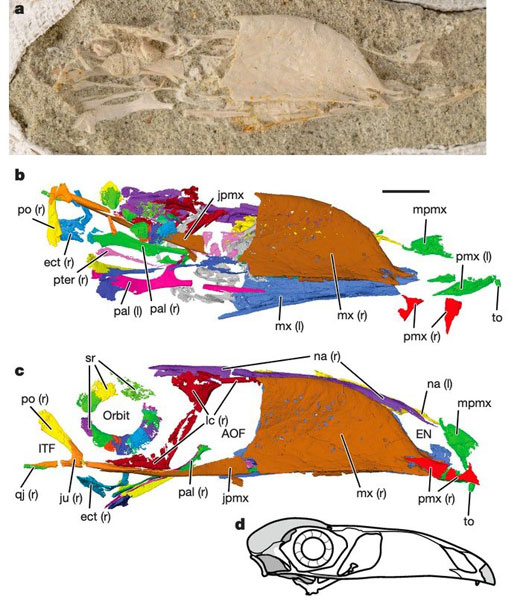Small Skull of Fossil Bird Has Big Implications (Falcatakely forsterae)
A team of international researchers including scientists from Ohio University, Stony Brook University (New York) and University College London have published a scientific paper describing a new type of enantiornithine bird (Falcatakely forsterae) from the Late Cretaceous of Madagascar.
Named Falcatakely, this crow-sized early avian offers a new perspective on the evolution of face and beak shape in the ancestral group leading to modern-day birds.
A Life Reconstruction of Falcatakely forsterae in the Late Cretaceous of Madagascar Surrounded by Other Archosaurs
Picture credit: Mark Witton
A Mesozoic Toucan?
Although palaeontologists are aware of a wide range of Mesozoic birds such as enantiornithines and hesperornithiforms which vary in size, flight adaptations and lifestyles, they all exhibit relatively conservative patterns of beak shape and development. Modern birds (neornithines), such as the finches studied by the famous naturalist Charles Darwin, show a huge range of beak morphologies, all associated with different feeding and behavioural ecologies. Falcatakely forsterae bucks this trend for birds from the Late Cretaceous, it has a beak morphology unlike other Mesozoic birds, one that is superficially similar to that of extant toucans.
Falcatakely forsterae, a combination of Latin and Malagasy words inspired by the small size and the scythe-like shape of the beak, which represents a completely novel face shape in Mesozoic birds.
Co-author of the scientific paper Dr Ryan Felice (University College London), explained how the study of birds have helped many scientists understand the subtleties of convergent evolution:
“Ever since Charles Darwin’s observations of Galapagos finches with differently-shaped beaks, birds have shaped our understanding of evolution through natural selection. This new discovery tells us even more about how the predecessors of modern birds evolved, by showing how different forces in different places can contribute to similar traits in distantly related animals.”
Falcatakely forsterae
Described from a single skull specimen which had remained uncatalogued for several years since its discovery in 2010, lead author Patrick O’Connor (Ohio University) and his colleagues used high resolution CT scans to build up a picture of the skull and beak.
The Skull of Falcatakely forsterae with CT Scans and Interpretative Line Drawing
Picture credit: O’Connor et al
Bird fossils are rare. Their light fragile bones tend not to fossilise well. Bird skulls are especially rare, but although crushed, the powerful CT scans have been able to reveal many unique features of the bones and the beak. For example, the researchers were able to identify a single preserved tooth in the premaxilla, probably one of several teeth lining the beak of this resident of north-western Madagascar some 68 million years ago.
Everything Dinosaur acknowledges the assistance of a media release from the University of Ohio and University College London in the compilation of this article.
The scientific paper: “Late Cretaceous bird from Madagascar reveals unique development of beaks” by Patrick M. O’Connor, Alan H. Turner, Joseph R. Groenke, Ryan N. Felice, Raymond R. Rogers, David W. Krause and Lydia J. Rahantarisoa published in Nature.
Visit the Everything Dinosaur website: Everything Dinosaur.








Leave A Comment